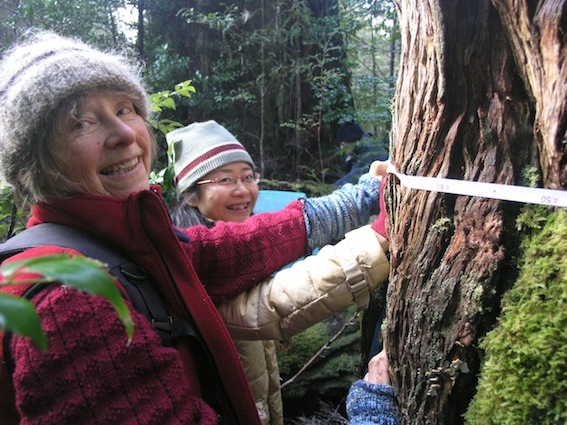Measuring carbon stored in forests remains one of the toughest carbon accounting tasks, but it’s not preventing some dedicated volunteers from giving it a go. [30 November 2010 | Peter Boyer]

Volunteers Gill Gravel (left) and Ping Kuang take a breast-height measurement of a forest giant in the Florentine Valley as part of the Wilderness Society’s carbon assessment program.
Next Sunday some nature-lovers will take to a southern Tasmanian forest for “a day in the Styx”. There they will listen to people talking about “citizen science”, and then go and start counting and measuring trees. And they’ll love every minute of it.
To other people, such tree-measuring will be a matter of indifference. Some may find it amusing that the tree-huggers are living up to their name. A few will be irritated by what they see as a pretentious show: bush day-trippers masquerading as scientists.
This is what the wilderness fraternity calls “citizen science”. It’s ordinary people getting out into wild places and methodically recording what they see there — plants, animals and pretty well everything else — to produce robust scientific data about this bit of Earth’s biosphere.
A strong proponent of citizen or community science is Tasmanian wildlife veterinarian David Obendorf. To him, the laypeople who undertake such work have taken an ethical stand, determining that they’re part of nature (not outside it) and that the planet’s future demands that more people get to know about its component parts and systems.
“The pure wonderment of thinkers like Charles Darwin, Alfred Wallace and Gregor Mendel has evolved into today’s strict scholarly pursuit,” says Obendorf, with the result that much science is now “owned” by a select academic fraternity and “the bureaucracies and corporations of the world”.
As Obendorf sees it, with the sustainability of human life on Earth at stake, now is the time for ordinary humans to resume the noble pursuit of scientific research. He cites the words of an Aboriginal Tasmanian as a mantra for citizen science: “We don’t own the knowledge; we share it.”
Liz Johnstone, coordinator of the Wilderness Society’s carbon-counting program, says the labour-intensive methodology was devised in consultation with forest scientists to ensure that plot selection and measuring were robust enough for data to be used in peer-reviewed research papers.
The first full year of work has seen assessment of randomly-selected plots in mature native forest in the Florentine Valley, as well as plots in the Styx Valley, Blue Tier in the state’s North-East and the Tarkine in the North-West.
In a 60-hectare Florentine coupe, dozens of volunteers measured nearly 2000 trees and logs in 10 circular sample plots each 120 metres in diameter. Preliminary results indicate that the coupe contains on average nearly 650 tonnes of above-ground carbon per hectare, including over 480 tonnes per hectare of carbon in living trees. By any global measure, this is a lot of carbon.
The accuracy of such voluntary work will be challenged. Although they have taken guidance and advice from forest scientists, the Wilderness Society workers are not trained foresters who make a career out of assessing how much merchantable timber can be taken from a forest coupe.
There are many people employed by government agencies and tree-harvesting companies who, if they felt so inclined, should be well-equipped to assess the tonnage of carbon held in Tasmanian forests. Forestry Tasmania owns data from thousands of plots around the state indicating an average carbon content well below the Florentine assessment. So who are we to believe?
Tasmanian forest managers have now begun to engage in public discussion about forest carbon. Forestry Tasmania representatives actively contributed to a wide-ranging forest carbon workshop in September organised by the environmental marketing consultancy Green Collar Solutions.
This is good news. The cheapest way to sequester carbon on land is to maintain forest cover, a message Australia needs to take to heart. A recent report in The Economist put Australia alongside big-logging countries like Brazil and Indonesia in the rate at which forested land is being lost — more than 500,000 hectares annually since 2005.
But a research paper just published in Nature Geoscience reported a drop in the proportion of global carbon emissions coming from deforestation, from 15 per cent in 2000 to about 10 per cent today.
Equally good news is the agreement between environmental and logging interests to phase out logging in Tasmanian native forest. As soon as possible, we need to end the big carbon losses inherent in clearfell logging of mature forest.
Forestry Tasmania seems to believe otherwise, saying that sawlog demand requires such logging to be continued for many years yet. It has maintained that new forest growth balances out carbon losses from logging, while citing commercial reasons for keeping its wood assessment data to itself (a position I have been critical of in earlier postings).
We can do without this tangle of competing claims over carbon emissions, but such dispute is symptomatic of land-use generally. CSIRO carbon scientist Dr Michael Raupach notes the perversity of international accounting rules that allow Australia to use a single high-land-clearing year, 1990, to claim subsequent “savings”.
Raupach is doubtful that Australia should include its own land use emissions in carbon pricing schemes: “There is a huge temptation to privatise the gains (take-up of carbon) and socialise the losses (emissions to the atmosphere). We have seen this happen again and again.”
There’s no reason to doubt this judgement, but it shouldn’t prevent us from measuring whatever land-use emissions we can and, if possible, finding ways to prevent them being “socialised”. Considering what’s at stake, we don’t really have an option.
